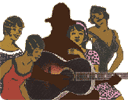Hi Eddy,
Yes, my custom OM-28 H from 1985 has bar frets. I requested them when I ordered the guitar because my main guitar in the years prior to getting that one was a 1930 OM-18 with bar frets, and I had become accustomed to them and really liked them. Bar frets differ from modern T frets in that they are much much harder and have far greater mass. I believe (and I have no proof) that the greater hardness of the bar frets, combined with their greater mass, contribute to the guitar having more sustain than with conventional fretwire. In addition, bar frets take much longer (three or four times as long, I think) to reach the point where they need to be replaced than do T frets. The additional mass also helps to stabilize the neck of the guitar and can actually be used to help eliminate mini-bows or bumps in the neck.
On the disadvantage side, most repair persons hate working with bar frets because they are so hard that it is quite difficult to file, level and dress them. In addition, not a lot of present-day repair persons have experience working with bar frets, since it is many years since they were commonly encountered on new guitars. Also, they take some getting used to in terms of the feel in the left hand--they stick up higher than almost all T frets, and you feel a bit of a bump when you cross them while sliding. They don't actually impede your slide, but you definitely notice the little bit of resistance until you get used to them. Finally, if you wanted to put bar frets on a guitar that did not already have them, you would probably have to widen the fret slots considerably. If you then decided you wanted to switch back to T frets, you would almost certainly have to get a new fingerboard put on your neck, since you took out wood to create space for the bar frets.
I don't believe you can get the sound and wear factor of bar frets with anything other than bar frets, but you may be wiser to look for an old guitar that already has them or commission the construction of a new guitar with them, rather than switch your current guitar to them, just in case you regretted the switch once you had had it done. It's a fairly major change to subject an instrument to that has not had them in the past.
All best,
Johnm










 Logged
Logged

